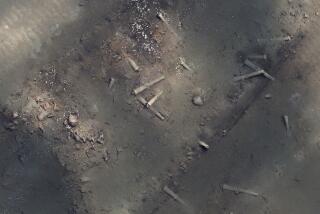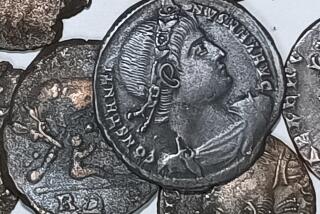Gull ‘Attack’ Leads to Sunken Treasure
- Share via
MONTEVIDEO, Uruguay — High-tech devices brought treasure hunters very close, but without luck and a sea gull’s unwelcome visit, they might not have found two Spanish ships that had been sunk and lost for two centuries.
Divers led by Ruben Collado were searching the shallow, rocky River Plate estuary in 1985 for the wreck of the Nuestra Senora de Loreto when the gull relieved itself on one of the divers’ boats.
“He was so mad he threw the pole into the water,” Collado said, referring to the long rod used to probe for sunken hulls. “He hit wood. It was the Loreto.”
A few months ago, another of Collado’s divers was in the murky water a few miles away, securing a cable around a cannon he could barely see, when he touched something small, smooth and round. It was a gold coin.
That confirmed the final resting place of the Preciado, a galleon sunk by pirates in 1792 after it set out for Spain with nearly 200 tons of gold and silver, almost all of it in coins.
“If it were not for that diver, today we’d have that sixth cannon and nothing else,” said Collado, a cheerful, 55-year-old Argentine with an engineering background.
The Preciado’s manifest listed jewelry and a solid gold, life-size statue of the Virgin Mary among the valuables. Collado says the treasure may be worth hundreds of millions of dollars.
By late May, 1,496 gold coins and three silver ones had been brought up from the Preciado. Many weigh 27 grams, about an ounce, are dated between 1749 and 1760 and bear the image of King Ferdinand VI.
Minted in Chile and never used, the coins seem in perfect condition. Also found were several gold bars and half-moons weighing up to 5 pounds each.
A spokesman for Christie’s, which auctioned the treasure from the galleon Nuestra Senora de Atocha in 1988, said the coins might be worth up to 10 times their weight in gold.
Collado said Preciado, or Precious One, is the ship’s nickname. Its real one began with the usual Nuestra Senora de, but he would not reveal it.
“It was luck, but a lot of hard work too,” Collado said of the discoveries. “I believe you make your own luck. When you spend years looking with sophisticated equipment, you can’t call that all luck.”
Although the Preciado is less than 900 yards off this city of 1.5 million, in water only 20 feet deep. It had settled into the mud and the mast was never visible because the ship went down on its side.
The pirates who sank it apparently did not stick around for plunder because soldiers were on their way, said Collado, who reviewed maritime archives in Spain.
It is said that a local man found the wreck long ago and would swim out for coins whenever he needed money. He was killed by robbers, and the beach was named Mulata for his widow, who stood on the sand at night, calling his name.
Collado said 23 previous expeditions were defeated by wind, waves and the mud that eventually buried both the Preciado and the Loreto, which went down in a storm in the mid-1700s.
He used a torpedo-shaped device called a proton magnetometer to locate the cannon, and divers search for gold with hand-held metal detectors. The hunt for the Preciado took nearly two years and cost $1.3 million.
Neither discovery has made Collado rich, at least not yet. The Uruguayan government reversed its decision to allow him 50% of the profit from the Loreto and has declared the ship a national monument.
Although Collado’s stake in the Preciado is now less than half, he said it is still substantial.
Removing the rock ballast that covers the Preciado’s treasure, then hauling up the booty, may take a year. But already, Collado dreams of the next challenge, finding the Nuestra Senora de la Luz.
He thinks it is nearby in the estuary, where hundreds of ships have sunk.
National Geographic, which has published articles on Spanish gold ships, confirmed that the Luz carried considerable treasure when it foundered off Montevideo.
More to Read
Sign up for Essential California
The most important California stories and recommendations in your inbox every morning.
You may occasionally receive promotional content from the Los Angeles Times.













